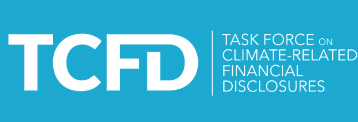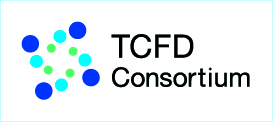We are strongly aware that addressing climate change and environmental issues is one of our most important management issues. Based on the framework of the Paris Agreement and the Japanese Government’s target of reducing net CO2 emissions to 0 by 2050, we recognize the roles that companies must play to realize a sustainable society, and we believe that solving these issues through business will lead to sustainable growth for the Group.
We will disclose information based on the TCFD framework so that we can communicate smoothly with a wide range of stakeholders, including shareholders and investors.


* In 2015, in response to a request from the G20, the Financial Stability Board (FSB) established the Task Force on Climate-related Financial Disclosures (TCFD) led by the private sector.
The TCFD released its final report (TCFD Recommendations) in June 2017, recommending that companies disclose information on “governance,” “strategy,” “risk management,” and “metrics and targets” regarding climate-related risks and opportunities.
Governance
In November 2022, the Company established the Sustainability Committee, an advisory body to the Board of Directors chaired by the President, to discuss, deliberate, and make resolutions on basic policies and important matters related to sustainability management. The committee is comprised mainly of directors and meets quarterly. Responding to climate change and environmental issues is positioned as one of the important themes in the “Meiko Network Japan Basic Policy on Sustainability.” We have also established the Sustainability Promotion Office to promote sustainability management. The Executive Manager of the Sustainability Promotion Office (Executive Officer) drafts the annual plan, manages the progress of indicators and reduction targets based on the annual plan, and submits it to the Sustainability Committee. The Sustainability Committee assesses, monitors, deliberates and resolves important matters such as annual plans, indicators, and progress status, and reports to the Board, thereby strengthening its monitoring and supervisory functions and ensuring effectiveness.
Strategy: Business Risks and Opportunities
The Company recognizes that the negative impact of climate change on society will be enormous and believes that it is important to contribute to the realization of carbon neutrality worldwide. Based on the 1.5°C scenario (IEA Net Zero Emissions by 2050 Scenario) assumed by the International Energy Agency (IEA), we will identify the risks and opportunities of our business stemming from climate change through scenario analysis and strengthen our response to various assumed risks.
Transition risks include the risk of earnings deterioration due to stricter legal regulations such as the introduction of a carbon tax, the development of educational materials that reduce environmental impact, an increase in capital expenditures such as the introduction of LED lights in schools and facilities, and an increase in financial burden due to taking flood risks into consideration in school layouts.
The company and its consolidated subsidiaries’ GHG emissions (Scope 1 and 2*) in the fiscal year ended August 2022 were 3,574 tons. Therefore, the Company has judged that the financial impact of the Company will be limited.
Physical risks include increased damage to schools and facilities due to the intensification of natural disasters such as floods or large-scale typhoons as a result of climate change, increased frequency of infectious diseases and high energy costs due to abnormal weather.
At the same time, we have positioned the strengthening of DX in response to the risks posed by climate change as a key strategic opportunity and we have developed individually optimized services tailored to customer needs in line with the Meiko DX Strategy Roadmap. We are also promoting paperless educational materials and communication with customers.
* Scope 1 and 2 refer to categories of greenhouse gases. Scope 1 refers to direct emissions by business entities, and Scope 2 represents indirect emissions from the use of electricity, heat, and steam supplied by other companies.
Risk Management
The Company has established a risk management system with the Risk Management Committee and Compliance Committee playing the central role in promoting flexible responses to risks. The Board of Directors, etc. identifies necessary items in the management process and conducts periodic monitoring to ensure appropriate management.
In particular, the Company has selected climate change as a company-wide important risk, and the Sustainability Committee, which consists mainly of directors, holds regular meetings to assess the impact on the business through scenario analysis.
The Sustainability Committee reviews the basic policy on sustainability, strategies, measures, etc. at least once a year taking into account the sharing of external factors such as global trends including climate change, changes in legal systems and regulations, progress of measures, and changes in future risks and opportunities.
The Executive Manager of the Sustainability Promotion Office (Executive Officer) manages the appropriateness of numerical reduction targets for activities related to climate change and the progress of measures. At the same time, the Executive Director of Sustainability plays a central role in promoting specific initiatives. For the effectiveness of each of the E, S, and G important issues, subcommittees will be established, and the heads of each division will be assigned to implement the PDCA cycle.
Metrics and Targets
We have been promoting the use of LED fluorescent lamps in schools. Looking ahead, with a view to the introduction of renewable energy, we will strengthen our efforts to reduce the greenhouse gas emissions of the entire Group by 10%* by 2030 compared to 3,574 tons in fiscal year ended August 2022 and to net zero by 2050.
*Scope 1 + Scope 2
